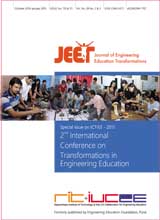

Journal of Engineering Education Transformations
DOI: 10.16920/jeet/2022/v35is2/22124
Year: 2022, Volume: 35, Issue: Special Issue 2, Pages: 137-143
Original Article
Sri Anggraeni, Aghisna Nuthfah Anshar, Aldi Maulana, Siti Nurazizah, Zalfa Nurjihan, Silmi Ridwan Putri, Asep Bayu Dani Nandiyanto*
Universitas Pendidikan Indonesia, Jl. Dr. Setiabudhi No. 229 Bandung, Indonesia
*Corresponding Author
Email: anggraeni_said@upi.edu
aghisnanuthfah@upi.edu
aldimaul@upi.edu
sitinurazizah@upi.edu
zalfanurjihan@upi.edu
Abstract: This research was conducted to determine the effectiveness of the method of learning the electroflotation process with a variety of stainless steel and copper electrodes and the voltages and voltages used. The experiment was carried out by treating domestic wastewater with the electroflotation method at various voltages of 6; 9; 12; 15; and 18 volts and variations of electrodes A, B, and C. The elements of the dispersed substance in the water medium, the pH level, and temperature in the water sample are measured first, then measured again to find out how much influence electroflotation has in separating pollutants. The application of learning is done by providing pretest questions, learning videos, and posttests. The results showed that sample A was good because it had an average value in the decrease in TDS as well as the temperature of the solution. While the results of the implementation of demonstration videos are effective, the score is not significant because it is likely that students already understand the concept as well as network factors. This research is expected to provide solutions to the problem of domestic oil-tainted water and improve the understanding of vocational school students about the concept of electro flotation to clear water.
Keywords: copper, electro flotation, stainless steel, teaching clears water
Subscribe now for latest articles and news.

